@Rob_Haug here a little later today and this time we will be focusing on the Arab-Muslim conquest of eastern Iran and Central Asia. The east played an important role in the fall of the Sasanian Empire, after all, this is where Yazdgird III (r. 624-651) met his final demise. rh 1/
The most famous battles of the conquest of the Sasanian Empire had happened well before Yazdgird’s death, of course. Qadisiyya which gave the Muslims control over Iraq and the Sasanian capital at Ctesiphon was in 633. Illustration, Astrabad, 1614 in British Library. rh 2/
Nearly a decade later, the Battle of Nahavand (642) opened up the lands beyond the Zagros. This was the turning point from which the Sasanians were unlikely to recover. Yet, Yazdgird held out for nine more years, fleeing east and eventually reaching Marw. rh 3/
As Yazdgird fled, he found himself reliant on the hospitality of his governors and local nobility. In some accounts he was traveling with an entourage including his wives, concubines, children, elderly family members, servants… but no soldiers or money. rh 4/
When Yazdgird reached Marw, the marzban or marchlord of the city, Mahawayh is reported to have reached out to the Hephthalite ruler of Badhghis (the highlands near Herat) known as the Nizak Tarkhan and asked for help in getting rid of the fallen emperor. rh 5/
The two conspired and Mahawayh told Yazdgird that an army of Turks/Hephthalites would come to his defense and help him retake his empire, but when they marched out of the city to meet these new allies, Yazdgird and his supporters were attacked, but the emperor fled. rh 6/
He found refuge in a mill, but the miller found Yazdgird hiding and, having heard about a reward on his head, either reported the emperor to Mahawayh or killed him himself. In many versions, Yazdgird& #39;s jewelry was a dead giveaway. illustration 1719, Punjab British Library. rh 7/
The body of the last Sasanian emperor was then unceremoniously thrown in the river.
The story of Yazdgird& #39;s fall tell us a lot about the status of the eastern frontier at the end of the Sasanian period.
Illustration from 1724, located in the Biblioteca Casanatense, Rome. rh 8/
The story of Yazdgird& #39;s fall tell us a lot about the status of the eastern frontier at the end of the Sasanian period.
Illustration from 1724, located in the Biblioteca Casanatense, Rome. rh 8/
Let& #39;s start w/ the relationship between Mahawayh and Yazdgird, the bonds between the political center and the frontier had broken down in the early 7th century. As the Sasanians focused their attention on the caliphate, eastern governors still worried about their frontier. rh 9/
A common thread we see in histories of the Arab-Muslim conquest from Iraq to Khurasan is that local notables, from the rural gentry to military governors chose to negotiate with the Muslims assuring the preservation of their status and wealth while exchanging rulers. rh 10/
Mahawayh was no different and he soon signed a treaty with the Muslims which gave them control of the city. The people of Marw had to garrison Arab soldiers in their homes. We know that this happened quickly because Arab-Sasanian coins appear at Marw already in 651. rh 11/
Now, what about the relationship between Mahawayh and the Nizak Tarkhan? Many sources tell of Mahawyh being married to a relative of the Hephthalite lord and the two appear to be in very close communication. As if diplomacy became important as centralized authority waned. rh 12/
This is not the only example of Sasanian elite allying with a Hephthalite force during the conquest of Khurasan. One of the major acts of resistance in the region came from the Qarinid noble Parthian family who raised a force of 40,000 from Badhghis, Herat, and Quhistan. rh 13/
the highlands that were the center of the Nizak Tarkhan& #39;s domains. They were unsuccessful and the head of the Qarin family was killed, but we see the potential for alliances. Nor was this new. The Qarinids had been part of the pro-Hephthalite party in the Sasanian period. rh 14/
The realities of Arab rule in Khurasan may have helped foster these relationships too. Many have described the process of conquest in the east as capture, rebellion, recapture and this is because many places appear to be conquered multiple times in our literary sources. rh 15/
This is much clearer in Transoxiana, which I will get to tomorrow, but in the early years this was because the Arab-Muslims were not an occupying force. They came during a campaign season, acquired loot/tribute and then went back to Basra in Iraq. No one stuck around. rh 16/
That was until 671, 20 years after the first "conquest" of Khurasan and the death of Yazdgird, when the governor Rabi` b. Ziyad al-Harithi established an Arab garrison at Marw consisting of 50,000 warriors and their families for an estimated total of 200k-250k. rh 17/
This garrison would allow for year round supervision of Khurasan but also regular and easier campaigns across the Oxus into Sogdiana and beyond... which will be my focus for tomorrow. Sorry for the delayed and abbreviated posts today, I will try to make up for it. rh 18/

 Read on Twitter
Read on Twitter






